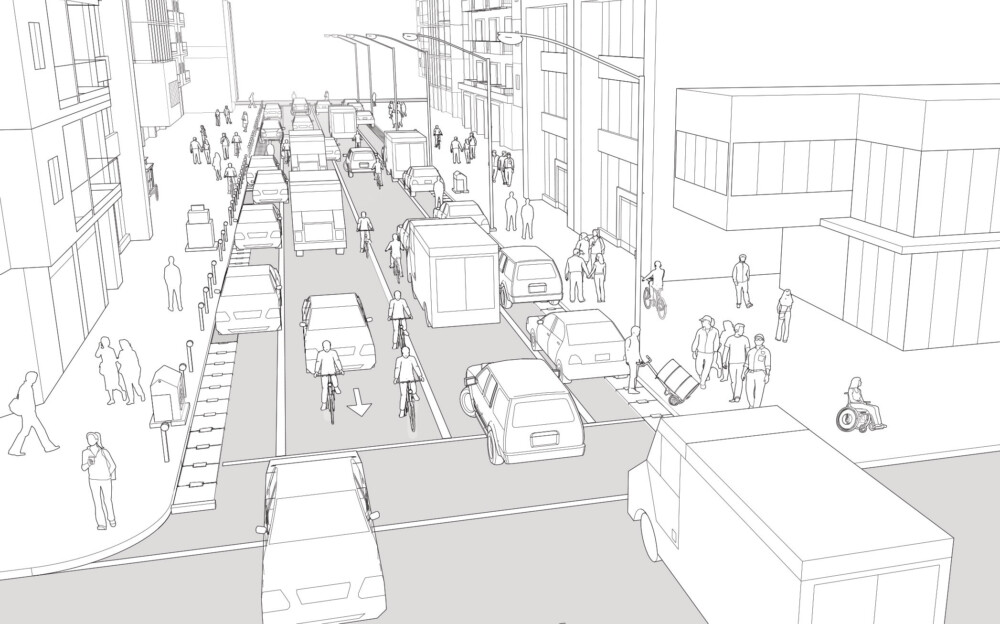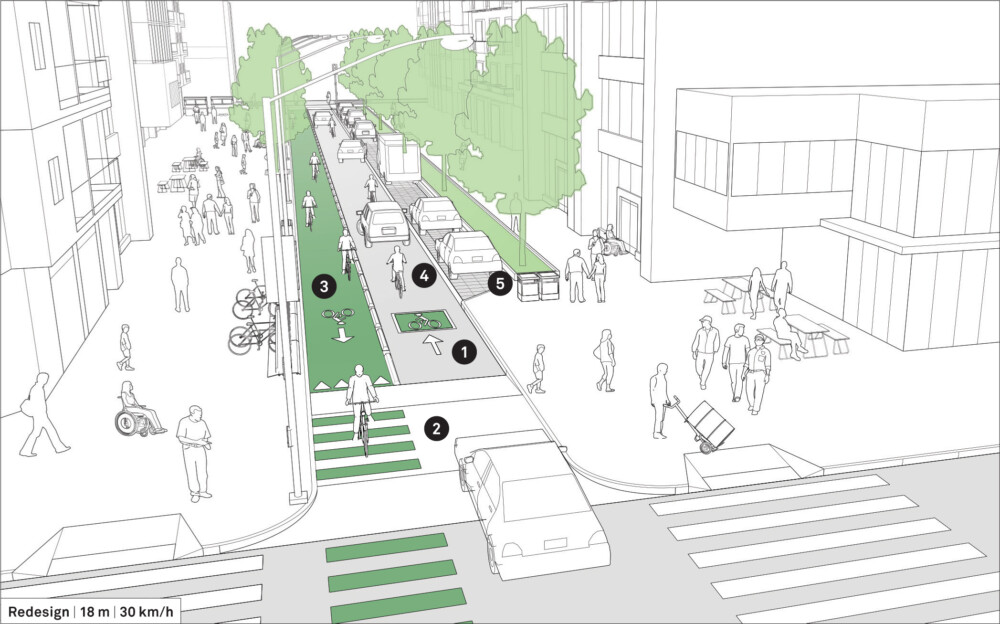-
About Streets
- Introduction
- Defining Streets
-
Shaping Streets
- The Process of Shaping Streets
- Aligning with City and Regional Agendas
- Involving the Right Stakeholders
- Setting a Project Vision
- Communication and Engagement
- Costs and Budgets
- Phasing and Interim Strategies
- Coordination and Project Management
- Implementation and Materials
- Management
- Maintenance
- Institutionalizing Change
- Measuring and Evaluating Streets
-
Street Design Guidance
- Designing Streets for Great Cities
- Designing Streets for Place
-
Designing Streets for People
- Utilities and Infrastructure
- Operational and Management Strategies
- Design Controls
-
Street Transformations
- Streets
-
Intersections
- Intersection Design Strategies
- Intersection Analysis
- Intersection Redesign
- Mini Roundabout
- Small Raised Intersection
- Neighborhood Gateway Intersection
- Intersection of Two-Way and One-Way Streets
- Major Intersection: Reclaiming the Corners
- Major Intersection: Squaring the Circle
- Major Intersection: Cycle Protection
- Complex Intersection: Adding Public Plazas
- Complex Intersection: Improving Traffic Circles
- Complex Intersection: Increasing Permeability
- Resources
Global Street Design Guide
-
About Streets
- Introduction
- Defining Streets
-
Shaping Streets
Back Shaping Streets
- The Process of Shaping Streets
- Aligning with City and Regional Agendas
- Involving the Right Stakeholders
- Setting a Project Vision
- Communication and Engagement
- Costs and Budgets
- Phasing and Interim Strategies
- Coordination and Project Management
- Implementation and Materials
- Management
- Maintenance
- Institutionalizing Change
-
Measuring and Evaluating Streets
Back Measuring and Evaluating Streets
-
Street Design Guidance
-
Designing Streets for Great Cities
Back Designing Streets for Great Cities
-
Designing Streets for Place
Back Designing Streets for Place
-
Designing Streets for People
Back Designing Streets for People
- Comparing Street Users
- A Variety of Street Users
-
Designing for Pedestrians
Back Designing for Pedestrians
- Designing for Cyclists
-
Designing for Transit Riders
Back Designing for Transit Riders
- Overview
- Transit Networks
- Transit Toolbox
-
Transit Facilities
Back Transit Facilities
-
Transit Stops
Back Transit Stops
-
Additional Guidance
Back Additional Guidance
-
Designing for Motorists
Back Designing for Motorists
-
Designing for Freight and Service Operators
Back Designing for Freight and Service Operators
-
Designing for People Doing Business
Back Designing for People Doing Business
-
Utilities and Infrastructure
Back Utilities and Infrastructure
- Utilities
-
Green Infrastructure and Stormwater Management
Back Green Infrastructure and Stormwater Management
-
Lighting and Technology
Back Lighting and Technology
-
Operational and Management Strategies
Back Operational and Management Strategies
- Design Controls
-
Street Transformations
-
Streets
Back Streets
- Street Design Strategies
- Street Typologies
-
Pedestrian-Priority Spaces
Back Pedestrian-Priority Spaces
-
Pedestrian-Only Streets
Back Pedestrian-Only Streets
-
Laneways and Alleys
Back Laneways and Alleys
- Parklets
-
Pedestrian Plazas
Back Pedestrian Plazas
-
Pedestrian-Only Streets
-
Shared Streets
Back Shared Streets
-
Commercial Shared Streets
Back Commercial Shared Streets
-
Residential Shared Streets
Back Residential Shared Streets
-
Commercial Shared Streets
-
Neighborhood Streets
Back Neighborhood Streets
-
Residential Streets
Back Residential Streets
-
Neighborhood Main Streets
Back Neighborhood Main Streets
-
Residential Streets
-
Avenues and Boulevards
Back Avenues and Boulevards
-
Central One-Way Streets
Back Central One-Way Streets
-
Central Two-Way Streets
Back Central Two-Way Streets
- Transit Streets
-
Large Streets with Transit
Back Large Streets with Transit
- Grand Streets
-
Central One-Way Streets
-
Special Conditions
Back Special Conditions
-
Elevated Structure Improvement
Back Elevated Structure Improvement
-
Elevated Structure Removal
Back Elevated Structure Removal
-
Streets to Streams
Back Streets to Streams
-
Temporary Street Closures
Back Temporary Street Closures
-
Post-Industrial Revitalization
Back Post-Industrial Revitalization
-
Waterfront and Parkside Streets
Back Waterfront and Parkside Streets
-
Historic Streets
Back Historic Streets
-
Elevated Structure Improvement
-
Streets in Informal Areas
Back Streets in Informal Areas
-
Intersections
Back Intersections
- Intersection Design Strategies
- Intersection Analysis
- Intersection Redesign
- Mini Roundabout
- Small Raised Intersection
- Neighborhood Gateway Intersection
- Intersection of Two-Way and One-Way Streets
- Major Intersection: Reclaiming the Corners
- Major Intersection: Squaring the Circle
- Major Intersection: Cycle Protection
- Complex Intersection: Adding Public Plazas
- Complex Intersection: Improving Traffic Circles
- Complex Intersection: Increasing Permeability
- Resources
- Guides & Publications
- Global Street Design Guide
- Streets
- Avenues and Boulevards
- Central One-Way Streets
- Example 1: 18 m
Example 1: 18 m


Existing Conditions
The above illustration depicts a two-way street with one travel lane in each direction, with mixed traffic and parking on both sides.
Frequent destinations on both sides of the street invite parking, stopping and loading that result in weaving traffic and turning conflicts.
A lack of cycle facilities encourages cyclists to ride on sidewalks, creating safety concerns for pedestrians.
Partially concealed drainage channels on both sides of the street present hazards to pedestrians and cyclists.

Bandung, Indonesia
Design Guidance
![]() When constrained two-way operation does not safely accommodate all users, consider conversion to one-way operation, allocating excess road width for pedestrians and cyclists.
When constrained two-way operation does not safely accommodate all users, consider conversion to one-way operation, allocating excess road width for pedestrians and cyclists.
![]() Reduce travel lane width to 3 m in order to avoid speeding. Add raised crossings at intersections to prioritize pedestrians and ensure slow traffic speed. See: Traffic Calming Strategies.
Reduce travel lane width to 3 m in order to avoid speeding. Add raised crossings at intersections to prioritize pedestrians and ensure slow traffic speed. See: Traffic Calming Strategies.
Widen sidewalks to accommodate commercial activity while maintaining the pedestrian clear path. See: Sidewalks.
![]() Repurpose the opposing travel lane as an exclusive, raised contraflow cycle track. Contraflow cycle paths are especially important where the cycling network would otherwise require cyclists to significantly detour. See: Cycle Networks.
Repurpose the opposing travel lane as an exclusive, raised contraflow cycle track. Contraflow cycle paths are especially important where the cycling network would otherwise require cyclists to significantly detour. See: Cycle Networks.
![]() Create a shared travel lane with vehicles and cycles in the same direction, with a maximum travel speed of 30 km/h.
Create a shared travel lane with vehicles and cycles in the same direction, with a maximum travel speed of 30 km/h.
![]() Add green infrastructure such as permeable paving under parking spaces, rain gardens, and trees along the sidewalk to help manage stormwater and make the street more appealing.
Add green infrastructure such as permeable paving under parking spaces, rain gardens, and trees along the sidewalk to help manage stormwater and make the street more appealing.
Parklets should be encouraged to provide additional public space.

Chennai, India
Adapted by Global Street Design Guide published by Island Press.
Next Section —